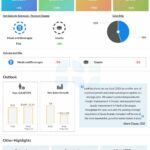
The Roth IRA has been called “the Swiss Army knife” of personal finance because of its flexibility and the tax-free status of its earnings. That’s the reason so many retiring workers move to roll their workplace 401(k) accounts into a Roth, and why so many financial advisors recommend converting a traditional IRA to a Roth.
The idea is that if you pay income tax on your retirement money now – especially when many account balances are significantly down – your tax-free Roth gains will make up the difference and possibly more.
But beware the 5-year Rule.
Below we’ll guide you through the ins and outs of the 5-year-Rule, but consider matching with a vetted financial advisor for free for more help managing a Roth rollover and other retirement needs.
The 5-year Rule: What You Need to Know
While the contributions to a Roth can be withdrawn at any time, you can’t touch the earnings unless the account’s been open for at least five years. So, if you’re rolling another retirement account into a Roth IRA in 2023, make sure you don’t need the earnings until at least 2028. If the account for the rollover is your first Roth IRA account or you opened your first Roth less than five years ago, the earnings will be taxed when withdrawn. One break is that even if a Roth you opened more than five years ago is closed, it still counts toward the 5-year rule.
And, yes, the 5-year rule counts even if you’re older than 59.5 – you need to satisfy both requirements or you lose the tax break on gains.
If you’re contemplating converting an Individual Retirement Account into a Roth, it’s even worse. The 5-year rule on Roth conversions requires you to wait the full five years before withdrawing any converted balances — contributions or earnings — regardless of your age.
That doesn’t diminish the attractiveness of a Roth account for people who want to take more control over their investments than they get through a workplace 401(k) or 403(b) plan, which can be limited to just a few proprietary mutual funds operated by the plan sponsor, a total lack of cheaper exchange-traded funds (ETFs), employer matching contributions stuck into company stock, as well as no control over the choice of fees charged to your account.
Another reason investors choose a Roth rollover or conversion is when they want to avoid the required minimum distribution rules (RMD) that kick in at age 72 – even on Roth 401(k) accounts. The Roth IRA is exempt from RMD requirements, which allows the money you would have been forced to withdraw to continue generating gains.
One problem investors face when planning a Roth rollover or conversion is the income limits that apply to contributions if your adjusted gross income (AGI) from your tax return is more than $144,000 for a single filer or $214,000 for joint returns. With a 401(k) or similar plan, the workaround is an exemption called “in-service distribution.” If you’re older than 59.5 and still working you can withdraw or rollover money from your 401(k). Most plans allow for these distributions under certain conditions, such as financial hardship, and many also allow distributions for participants older than 59.5, but not all, so you’ll need to check with your plan sponsor.
For Roth conversions from a traditional IRA, you can get around the income limits with what’s known as a back-door Roth conversion. You might want to do that sooner than later since some Congress members have been working to close the back-door loophole for a while now. If you’re making a Roth conversion, you’ll also need to watch out for the “pro rata” rule in the first five years, which applies to conversions from accounts that include pre-tax, deductible contributions and after-tax, nondeductible contributions. One trick that can work in that case is to convert only a small amount for the first five years.
As always, tax and investment strategies can be complex and depend on each individual’s situation, so consult a tax or financial advisor first.
If you’re ready to be matched with local advisors that can help you achieve your financial goals, get started now.
Bottom Line
Converting a traditional IRA to a Roth can be advantageous for many in light of the flexibility and tax-free status of the latter’s earnings. But while the contributions to a Roth IRA can be withdrawn at any time, remember that you can’t touch the earnings unless the account’s been open for at least five years, even if you’re 59.5 or older.
Retirement Planning Tips
-
Consider talking to your financial advisor about the best ways to manage retirement assets and taxation if you’re considering a Roth conversion. SmartAsset’s free tool matches you with up to three vetted financial advisors who serve your area, and you can interview your advisor matches at no cost to decide which one is right for you. If you’re ready to find an advisor who can help you achieve your financial goals, get started now.
-
A Roth IRA conversion is not the same thing as an IRA rollover. With a rollover, you’re moving money from one like retirement account to another. For example, if you leave your job you might decide to roll your traditional 401(k) assets into a traditional IRA. Or you might roll a Roth 401(k) into a Roth IRA. The IRS does limit how often you can roll funds over. Generally, you cannot make more than one rollover from the same IRA within a one-year period.
Photo credit: ©iStock.com/DNY59
The post Doing a Roth Rollover? Beware the 5-Year Rule appeared first on SmartAsset Blog.








